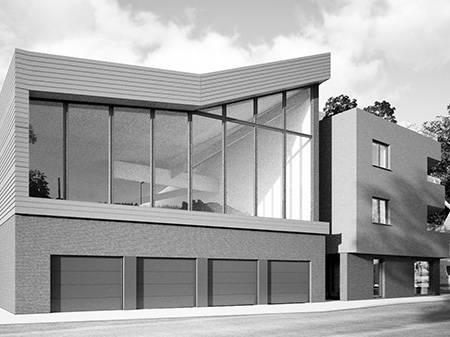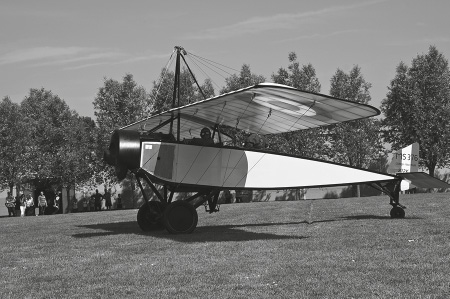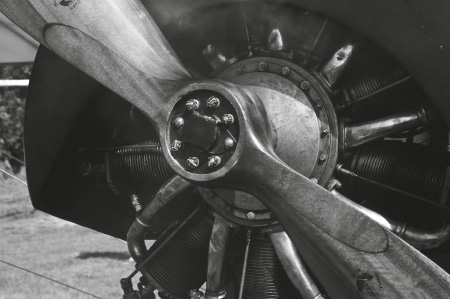
The pavilion will not only bring the story of Georges Guynemer, but also of the air battles during the First World War.
Photo: © VOF Guynemer

Showpiece of the pavilion will be the replica of a Morane-Saulnier L, built by VTI Ieper.
Photo: © Kurt Vandewalle

The pavilion will give the visitor a good view on the fast growing technics of the airplanes during the First World War.
Photo: © Kurt Vandewalle

The Guynemer Pavilion
Georges Guynemer's name and the municipality of Poelkapelle have been inextricably connected with each other for 100 years. Many associations, squares, houses, footpaths, regional products… are often named after this French fighter pilot.
Since the 8th of July 1923, an elegant monument, featuring a stork, has adorned the roundabout in the centre of Poelkapelle. It is one of the greatest monuments dedicated to one hero who fought in the Ypres Salient during the First World War. The 'flying ace' Georges Guynemer therefore still has an incredible impact on the municipality and the region today.
A pavilion, named after him, will open 100 years after he lost his life close to Poelkapelle. The pavilion not only tells the story of his life, but also of many other pilots, whether they were friend or foe. In the pavilion special attention is also paid to the enormous development of aviation during the First World War. Of course, the highlight for the visitors to the pavilion will be a replica of the Morane-Saulnier.

The pavilion will not only bring the story of Georges Guynemer, but also of the air battles during the First World War.
Photo: © VOF Guynemer
Georges Guynemer
In the Pavilion, all the fine details of the extraordinary life of the combative Georges Guynemer are set out. The use of information panels, multimedia and a real movie theatre will give you a clearer perspective of the life of this innovative and ambitious French squadron commander in the early years of aviation.

Showpiece of the pavilion will be the replica of a Morane-Saulnier L, built by VTI Ieper.
Photo: © Kurt Vandewalle
Friend and foe
In the First World War, fighter pilots were very often regarded as heroes for their courage and boldness. The pilots were also admired by many people, because aircrafts had only been known for 10 years, and pilots were compared with the knights of history who fought against each other. The story of the fight between Guynemer and the German pilot Udet is a perfect example of this. When Guynemer noticed that Udet's machine guns had blocked during their fight, he saluted his rival and flew off. For his exploits and chivalrous behaviour he was given the nickname "Guynemer, the legendary".
In the pavilion a great deal of attention is paid to Georges Guynemer's supporters as well as to his adversaries.

The pavilion will give the visitor a good view on the fast growing technics of the airplanes during the First World War.
Photo: © Kurt Vandewalle
Morane-Saulnier
The highlight of the pavilion will be a replica of the Morane-Saulnier. This replica has been constructed by the students of the Technical College in Ypres (VTI Ieper) and is a reproduction of the aircraft in which Georges Guynemer attained numerous victories.
He attained his first aerial victory, flying his Morane-Saulnier Type L (Parasol), together with his mechanical engineer and machine gunner, Charles Guerder. This aircraft had not yet been given the name ‘Le Vieux Charles’ ('The Old Charles'), as all other planes that he flew later had. Guynemer flew a number of different types of planes: Morane-Saulnier Type L, Nieuport 10, SPA3, SPAD VII, SPAD XIII and SPAD XII. The last mentioned plane – with two machine guns – was developed after Guynemer had made some comments on the SPAD VII and suggested proposals for improvement. In 1917, at Guynemer's instigation, a 37 mm canon was mounted on the aircraft. When Guynemer started to fly a Nieuport, he named all his aircrafts 'Le Vieux Charles'. The Escadrille MS3 changed its name to Escadrille N3 (by Nieuport). Only from about June 1916 onwards, was the 'Stork' symbol used on the aircrafts.

OPENING TIMES OF THE PAVILION
- February - November
- Wednsday -> Saturday : 10h - 18h30
- Sunday : 10h - 12h30
- Annual holiday from 1 December 2025 until 1 March 2026
ENTRANCE FEES: PAVILJON
INDIVIDUALS
6 years and above5.00 euro
GROUPS
From 10 persons4.50 euro
From 30 persons4.00 euro
GUIDE
Per tour40.00 euro
